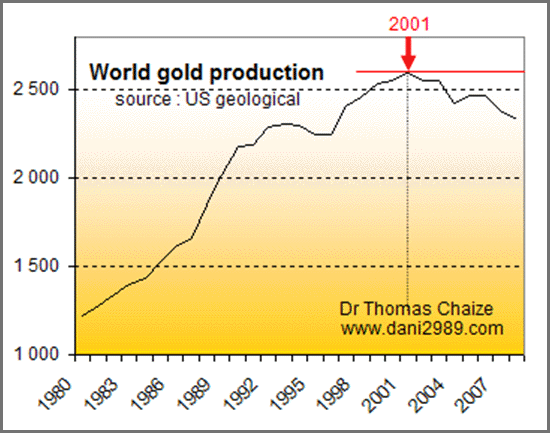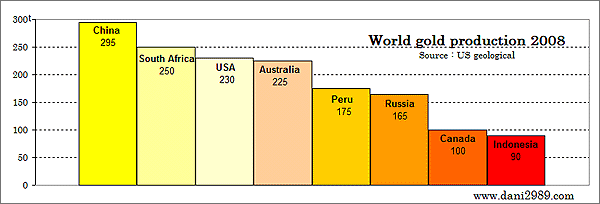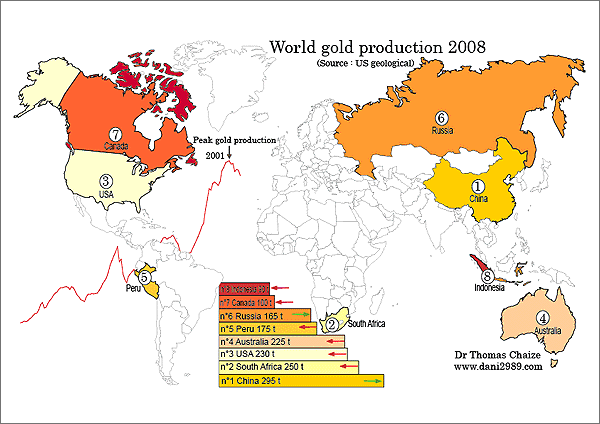2009 World Gold Production falling - Dr. Thomas Chaize - Good for Silverado!
posted on
Jun 11, 2009 02:51PM


Gold production in the World 2009
May 19, 2009
Dr Thomas Chaize
Historically goldmines are poor in precious yellow metal despite all the difficulties the world production of gold was able to grow. It was multiplied by 4 in one century. However, since 2001 the world production of gold seems to have peaked. Gold production still has declined by 50 tonnes in 2008, despite a price of gold record ounce to 872 dollars. This year, the hierarchy of gold producing countries has been further upset by the leadership of China and the decline in gold production of South Africa. After one century reign over the world gold production, South Africa loses again its title.
I. The peak of world gold production.
For 5 years, I am indicating that peak of world gold production was reached in 2001. This year gold production in the world still has declined. World production of gold is 2330 tons of gold in 2008, a decrease of -2.1% compared to gold production in 2007, and -10.4% compared to 2001...
The price of one ounce of gold as an annual average was 271 dollars in 2001, 871 dollars one ounce in 2008, an increase of 221% in the gold price in dollars.
Do not you find that there is something wrong? Rising gold price of 221% associated with a decline in gold production of -10.4% ...
At first glance, this might seem normal. Indeed, a very long time is needed for a gold mine for an investment to be effective (ie to produce the first gold grams). Today it is over 7 years that the rising price of gold has begun. Finally, there is still no sign of resumption of growth in gold production in the world.
On average for 110 years, world production of gold increased by 1.8% per year, but since 2001 the production decline by an average of -1.3% per year while the price of gold has increased by 15% per year (on average) during the same period.

II. The major producing countries gold.
Gold production in China is the largest in the world. Its production is 260 tonnes of gold, the gold production record for China. It increased by 7% since 2007 and 59% since 2001. China is the only country among the major gold producers with a growing production. We often speak of the gold demand from China; we forget that China has become a major producer of gold.
South Africa has lost its place as No. 1 in gold production in 2008 as in 2007. It is in second place with a gold production estimated at 250 tons. It is slightly down from 2007 and down -38% compared to 2001. The decline in gold production in South Africa in 2008 is attributed to the problems of electricity, but since almost 40 years the production of South African gold decreases because of the exhaustion of the best deposits.
The gold deposits in the Witwatersrand region represent for the gold production what the Ghawar region is for oil. Its maximum production of gold was achieved almost 40 years ago, no gold producer will never produce as much or that the Witwatersrand in 1960s.
The USA is third with a production of 230 tonnes of gold. The state of Nevada is 78% of total gold production in the USA with 175 tonnes of gold. This first gold producer in the USA alone totaled half the gold production in the USA in its nine goldmines. Gold production in the USA declined by -3% compared to 2007 and -31% since 2001. Gold production decline in the U.S. continuously since 1998.
Australia is the fourth largest gold producer in the world with 225 tonnes of gold. The Australian gold production decline of -9% over 2007 and -27% since 2001. The Australian gold production declining steadily since its peak in 1998.

Peru produced 175 tonnes of gold in 2008, 63% comes from two provinces of northern Peru: Cajamarca and La Libertad. Gold production in Peru grew by 21% since 2001 and 3% since 2007. We must be wary because it hides a lower production of -16% since 2005 by the fact that 58% of gold production from two large gold mines have seen their gold production down since 2005 and 2006.
The Russian goldmines produced 165 tonnes of gold in 2008, up 5% compared to 2007 and up 8% compared to 2001. The increase remains below to 3% of the production record of 2002. In Russia, the three largest producers of gold produce each year a third of Russian gold. Russia retains a potential for growth in gold production.
Canada. It is The country of mining, not only for these abundant resources but also because half the mines in the world are publicly traded in Canada. It is important to clarify that the country has geologists and mining engineers among the best in the world. Despite this, gold production fell by -43% in Canada since 1991, -30% compared to 2001 and -1% compared to 2007. Canada produced 100 tonnes of gold last year. The goldmines of Ontario have produced 50 tons of gold, in Quebec 28 tonnes of gold. Gold production in these two provinces account for more than three quarters of gold production in Canada.
Indonesia is also a significant gold producer with 90 tonnes of gold produced in 2008, down -24% compared to 2007 and -31% compared to 2001.
Consider the first 8 gold producers in the world, 7 of them are below their level of gold production record. These countries have seen their gold production fall by -14.3% since 2001, their production fall faster than the total gold world production. These eight countries produce 2 / 3 of the gold in the world, that's the problem...
III. The small producing countries gold.
The decrease in production of large gold-producing countries was partly offset by increased gold production of small gold producers during the period 2003 to 2006. In 2008, these countries have failed to offset the decrease in gold production of the major gold producing countries. They are unlikely to succeed either in 2009. One reason for this non-compensation of production is the crisis. It makes obtaining credit more difficult for gold producers. Formerly financing a mining project was already a big problem, imagine now! For a small goldmine which the banker can not pronounce the name which he is unable to locate it country on a world map, so obtaining credit is an impossible mission.
Gold is well distributed on the Earth surface (in small amounts) then the small gold producers are fortunately many to compensate for their low production, here are the most important: Argentina, Bolivia, Brazil, Chile, Colombia, Ghana, Kazakhstan, Mali, Mexico, Morocco, Uzbekistan, Papua, Philippines, Tanzania ...
The list of small gold producers is composed of 90 countries. They have at least one mine that produces gold. Together, they produce only half of the production of 8 leading producer of gold. The goldmines of these small producers being poorer (in gold) and smaller and more scattered than those of the major producing countries, they are naturally less profitable. Only temporarily, their production could offset the decline in production of major gold producers.

The downward trend in gold production in the world seems to me even more evident today than in 2003. The largest countries gold producers in the world had their first gold fever there over one century (1838 in Siberia (Russia), 1848 in California (USA), 1851 New South Wales (Australia) 1886 the Witwatersrand (South Africa), 1896 the Klondike (Canada)), the gold's vein is now exhausted. The time for gold nuggets of several tens of kilograms, of alluvial gold glitter is gone. Now it's time for tons of ore or rock for a few grams of gold. The gold production of historical producers of gold decreased more and more each year. A small one-time increase of their gold production is possible, but in no way a reversal.
Both countries have a special situation in respect of gold production: Russia and China. I will trace in another study the reasons for this feature in more detail.
There is a gap between the goldmines production in the world and the demand for gold (jewelry, electronics, dental, coins and medals of gold, investments) of over 1000 tonnes of gold per year since over 20 years. This deficit is met by recycling and sales of central banks. In this situation of chronic deficit, we easily imagine the consequences of the inevitable decline in production of mines on the price of ingot. For 8 years, gold production decline. It is accompanied by a sharp rise in gold prices. Imagine what will happen to the production of gold in the world if gold prices drop! World production of gold needs gold prices high just to maintain a minimum level of production. A decline in the price of gold would cause a sudden drop in gold production. The inevitable consequence would be a very violent increase in the price of gold. For this reason, the gold price should continue to increase at the same pace. A diminished production of gold is then maintained. We avoid a rush worthy of the nineteenth century.
You can receive my free annual analysis of the production of gold and silver by subscribing to my free mailing list to this address. (The production of silver is my subject in June) 1
Dr Thomas Chaize
www.dani2989.com
| ...return to Top of Page | ...return to Index Page |